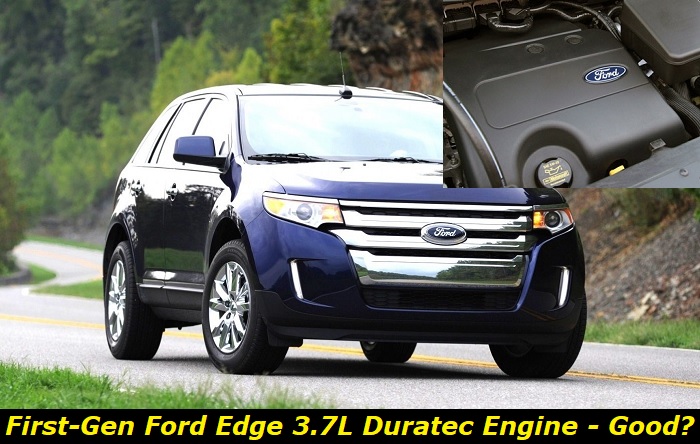Ford Edge was first introduced in the market in 2006. It is a mid-size compact crossover sport utility vehicle that derived its name from a trim package of the Ford Ranger. The first generation of the Ford Edge was produced between 2006 and 2014. The iconic Ford Duratec engine powers the C-SUV Ford Edge.
Today, we will look at the 2006-2014 3.7L Duratec engine that powers the Ford Edge. Different engines power this range of C-SUVs to suit the needs of many customers. Ford Edge lovers can pick the 2.0L EcoBoost I4, the 3.5L Duratec V6, or the 3.7L Duratec V6 engine. We will look into the problems affecting this engine, how long it lasts, and its specifications.

Key features and my opinion about the engine
- Production years:2009-2020
- Average lifespan of 3.7L V6 Duratec:210,000-250,000 miles
- Fuel supply type:port injection
- Power range:272-350 hp
- Fuel efficiency:bad
- Engine block material:aluminum
- Engine reliability score:medium
- The most common problems:water pump failure, phasers are pretty weak, oil leaks are common.
Understanding the 2006-2014 Ford Edge 3.7L Duratec engine
Ford introduced the Duratec engine in 1993. Ford designed the initial engine in collaboration with Porsche. The name and badge were exclusively reserved for gasoline-powered vehicles with 4, 5, and 6 cylinders. The use of the name Duratec on Ford engines is now ambiguous and is not reserved for any one specific type of engine.
The 3.7L engine is the premium pick you can get from the Ford Edge. It is powerful and has ample torque to take you across even the roughest and most challenging terrains. The 3.7L Duratec engine is quite popular and is installed in many cars, including Ford F150, Ford Mustang, and Lincoln MKT. The engine, also produced by Mazda, is also found in the 2008 Mazda CX-9.
The 3.7L Duratec engine has a bigger displacement than the 3.5L version mainly because the bore is bigger by 3.00 mm. In addition, the cast in-liners in the cylinders fully float at the top of the block. To ensure the engine performs optimally in power delivery, the manufacturer has equipped it with a forged crankshaft made of tough alloy steel.
The specifications of the 2006 - 2014 Ford Edge 3.7L Duratec Engine
Ford interchanges the Duratec name and Cyclone on its DOHC gasoline V6 engines introduced in 2006. This engine's block and head are made using cast aluminum, while the timing drive system is driven using a timing chain. Ford has used aluminum metal in making the rear sump and the rear seal cover plate can be removed.
Below are the key specs that make the 3.7L Duratec engine stand out:
- It has a displacement of 3,726cc or 227.4 cu in
- The engine block and head are made of aluminum
- It's a gasoline engine
- It has 6 cylinders and 4 valves per cylinder
- Its bore diameter is 95.5 mm, but the stroke is identical to the 3.5L engine at 86.7 mm
- 4130 structural alloy steel used to make the forged crankshaft
- The pistons come with oil squirters and 6-bolt billet steel main caps
- Older than 2011 versions come with VCT, and newer ones come with Ti-VCT
- 5.5 mm stems for the valves
- The intake valve will lift up to 9.8 mm while the exhaust one up to 9.1 mm
- Ford has equipped the engine with Front-end-accessory-drive, and it doesn't have any tensioners or idlers
- The intake manifold is in two pieces
- The internal combustion engine is four-stroke and naturally aspirated
- Power in horsepower is 268-305 HP (200-227 kW) at 6,250 - 6,500 RPM
- Torque per pound per foot is 260-280 lb-ft (353-380 Nm) at 4,000 - 4,250 RPM
- Engine oil capacity is 5.7 liters with an oil filter
- The oil change interval is 10,000 miles or 15,000 kilometers per 12 months.
- The valve train layout is a dual overhead camshaft (DOHC)
- It has a V configuration, hence the V6 badge
What are the common problems affecting the 2006-2014 ford Edge 3.7L Duratec engine?
The 2006-2014 Ford Edge 3.7L Duratec engine is very efficient and reliable. The engine is guaranteed to serve you for many years with proper and timely maintenance. But like every other engine or machine, this engine is susceptible to problems. Below are some of the most prominent issues that a Ford Edge running on a 2006 to 2014 3.7L engine is likely to be encountered:
- Water pump failure
The water pump failure remains one of the most significant issues hampering the 1st-gen 3.7L Duratec engine performance. The water pump in this engine and the 3.5L and the 3.5L EcoBoost is mounted internally and driven by a timing chain. This means that whenever the pump fails, antifreeze is deposited into the crankcase.
When antifreeze is dumped into the crankcase, it mixes with engine oil, and this causes potential danger to the connecting rod bearings and the head gasket. There are no symptoms to look out for because all this happens inside the engine. The timing chain is hidden behind the engine's front cover. The failure of the water pump causes severe damage inside the valvetrain and the cylinders too.
The cost of repairing the engine runs into thousands of dollars mainly because the engine needs to be removed from the vehicle and disassembled to access the pump. In addition, in certain instances, the water pump has to be replaced entirely, making the repair quite expensive.
Because these issues affected many 2006-2014 Ford Edge owners, a class action lawsuit was filed. However, this action was dismissed, meaning that Ford gave no recall. As of 2011, the water pump issues dropped drastically. This is because Ford revised the timing chain design and the sprockets. On the one hand, Ford fought not to pay the heavy damages that come with losing a class action suit. But on the other hand, it worked on the issues its customers were complaining about.
From 2006 to 2011, the 3.7L Duratec engine was equipped with a variable cam timing (VCT) on the intake shafts. However, in 2011 the manufacturer changed the VCT to twin independent VCT (Ti-VCT) for both the intake manifold and exhaust. This not only upgraded the engine to compete in the now vibrant V6 field but also solved some of the issues the previous version of the engine was encountering.
- Actuated cam phasers failure
Several 2006 to 1014 Ford Ede owners have reported cam phasers failing. This problem affects the timing chain, which further affects the camshaft's rotation angle. The Check Engine Light (CEL) should light up when the cam phasers fail.
The OBD diagnostics machine should read the error codes pretty easily, and the 'timing issue' will show. The phasers can be replaced, but in other instances, significant works need to be done to restore the engine.
Some Edge owners report that they hear loud ticking noise when it's freezing, and the engine continues producing the sound until it warms up. Edge owners generally agree on online forums that the injectors make the ticking noise, which shouldn't be an issue.
- Exhaust control valve solenoid
The exhaust control valve solenoid can, at times, fail. In some cases, the camshaft position sensor will also need to be replaced whenever the control valve solenoid fails. The indicating sign that these parts are failing or have failed is the check engine light. These parts are best replaced. However, the cost is high because the engine will need to be disassembled to access the failed parts.
How long does the 2007-2014 Ford Edge 3.7L Duratec engine last?
Like every other engine, the 3.7L Duratec engine fitted in the 2006 to 2014 Ford Edge will serve you for many decades when good care is accorded it. Edge owners and critics generally agree that this C-SUV can serve you well over 200,000 miles. However, some critics and mechanics think this engine will serve you for around 150,000 miles.
If you are buying a used Ford Edge, it is worth noting that the vehicle will have over 100,000 miles on its odometer. This being the case, you should be ready to replace the ABS control module, fuel-sending unit, and heater hose.
Verdict
2006 to 2014 3.7L Ford Edge Duratec engine is one of the top-performing engines from Ford. The engine has given the Ford Edge an edge in the C-SUV section since it packs the car with power and reliability. Customers and critics agree that this model presents one of the best cabins even though it doesn't come with a third row as some in the market.
When it comes to the overall verdict of the 2006 to 2014 Ford Edge 3.7L engine lifespan, it only manages to score less than an average mark. This is because it is dogged by water pump failure issues. The engine's design is such that whenever there is an issue with the timing chain or the pump itself, there are a whole lot of problems to deal with.
Ford never issued a recall but rather redesigned the engine so that owners of the same vehicle produced in 2011 onwards rarely encountered the water pump failure problem. Despite the said issues affecting the engine, owners of this car should expect to enjoy driving it for at least 150,000 miles without encountering any problems.
About the authors
The CarAraC research team is composed of seasoned auto mechanics and automotive industry professionals, including individuals with advanced degrees and certifications in their field. Our team members boast prestigious credentials, reflecting their extensive knowledge and skills. These qualifications include: IMI: Institute of the Motor Industry, ASE-Certified Master Automobile Technicians; Coventry University, Graduate of MA in Automotive Journalism; Politecnico di Torino, Italy, MS Automotive Engineering; Ss. Cyril and Methodius University in Skopje, Mechanical University in Skopje; TOC Automotive College; DHA Suffa University, Department of Mechanical Engineering






Add comment